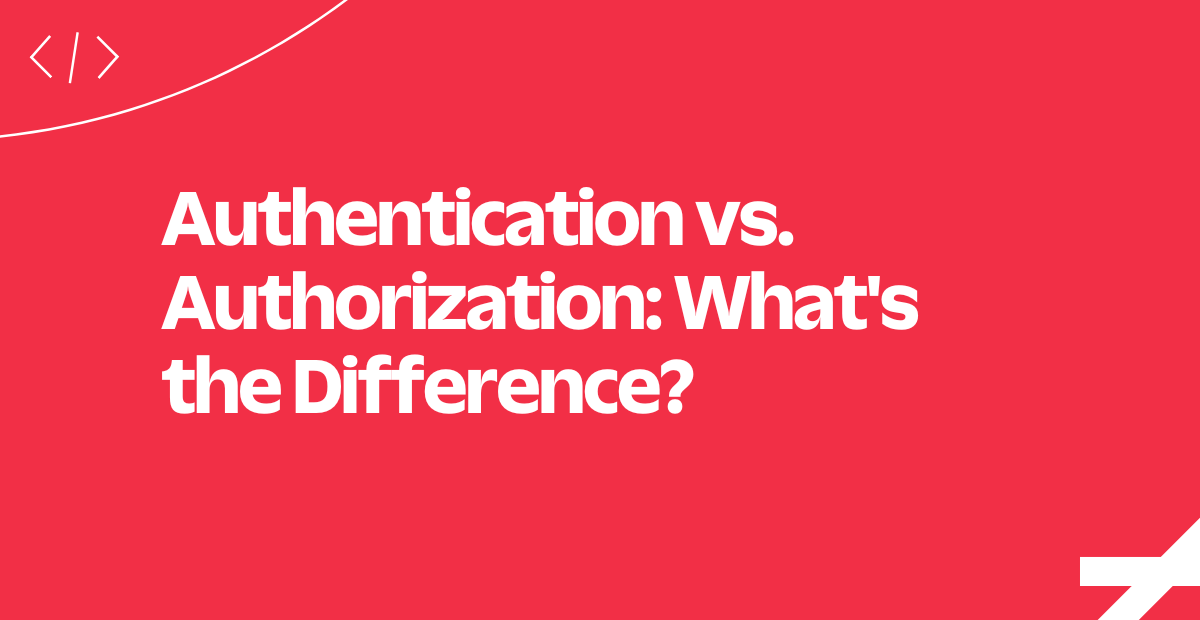Authentication vs. Authorization: What's the Difference?
Time to read: 3 minutes

Massive data leaks that jeopardize confidential user information—and the networks that hold them—have become all too common. In a digital world rife with security breaches and malicious hackers, authentication and authorization are must-haves for any organization.
But what does it look like to authorize vs. authenticate, and how do these measures protect companies and users from unwanted cyberattacks? These terms are often interchangeable, sharing certain similarities and existing to protect private resources, but knowing the differences is key to helping your company determine which security solutions to implement.
Here, we’ll explore authentication vs. authorization, along with common methods and examples for each. Before we dive into the difference between authentication and authorization, let’s define each.
What is authentication?
Authentication is validating a user’s identity before they access a certain network, system, or account. Some common forms of authentication include:
- Basic authentication: Your social media account can be a form of authentication when you input your username and password to log in.
- Two-factor authentication: You may have to prove yourself twice, as an extra layer of caution with some platforms that require two-factor authentication. Examples of two-factor authentication include sending a temporary personal identification number (PIN) to your email, asking for a biometric scan, or providing a list of security questions that only you can answer.
- Mobile authentication: Your smartphone provides you with a convenient way to verify your identity. Examples of mobile authentication include a unique code sent via SMS or biometrics.
- Silent network authentication: Your phone’s carrier connection can verify your phone number through silent network authentication. Without the need for a temporary passcode or external app involvement, this authentication method reduces a hacker’s ability to steal your account.
What is authorization?
The main difference between authorization vs. authentication is what you’re trying to access—authentication is for accessing an account, and authorization approves or denies a request to access certain data. It’s a necessary process that protects the company and its database, ensuring that users can only view the information they’re allowed to see.
Google Docs is a classic example. After the original document owner finishes their assignment, they must determine who to send it to for review. Instead of allowing complete and unrestricted access, they can choose a select few and manually grant permission. That way, only chosen colleagues can view and comment on their work.
There are 2 common types of authorization:
- Role-based access control (RBAC): RBAC allows access to different tiers of information depending on user roles. In other words, some users will have higher levels of clearance than others depending on their title and responsibility. They’ll be able to view data that others can’t.
- Attribute-based access control (ABAC): ABAC, on the other hand, relies more heavily on a user’s attributes to grant authorization. These attributes may include a person’s security clearance, the file’s owner, the type of action desired (such as viewer vs. editor), and the location of an access attempt. When the request doesn’t meet a company’s approved characteristics, the system will view the request as a potential security risk and deny access. ABAC is the more innovative authorization method to meet the needs of our current—and constantly evolving—digital world.
Main differences between authentication and authorization
The difference between authentication and authorization is clear—while authentication authenticates a person’s identity before allowing successful login, authorization authorizes their ability to access a specific file, page, or resource that reveals highly sensitive information. Authentication requires the user to act, but authorization puts the onus on the server or site.
So what happens when websites authorize vs. authenticate? Let’s say you have exclusive VIP access to a concert. Before entering the venue, you must undergo an extensive security check and present a valid form of ID that proves you are the ticket holder—authentication. Then, once you’re inside, you have to show the ticket to an employee to ensure you have proper permissions to go to your seat—authorization.
From a business standpoint, the difference between authorize and authenticate might mean a user can authenticate their identity by providing a correct username and password combination, while authorization is a requirement to view or edit certain files.
Learn more about authentication vs. authorization with Twilio
As you navigate various user security measures for yourself or your business, knowing the difference between authorization vs. authentication can make a world of difference. However, keep in mind that these 2 processes often work in tandem to maximize security efforts and add extra layers of protection. That’s where Twilio comes in.
In the face of malicious cyberattacks and unwarranted data leaks, Twilio Verify API employs these efforts to help you build a strong defense system and preserve highly personal user information. If you’re looking to learn more about authentication vs. authorization and implement multifaceted security solutions, sign up for a free account to get started.
Related Posts
Related Resources
Twilio Docs
From APIs to SDKs to sample apps
API reference documentation, SDKs, helper libraries, quickstarts, and tutorials for your language and platform.
Resource Center
The latest ebooks, industry reports, and webinars
Learn from customer engagement experts to improve your own communication.
Ahoy
Twilio's developer community hub
Best practices, code samples, and inspiration to build communications and digital engagement experiences.


